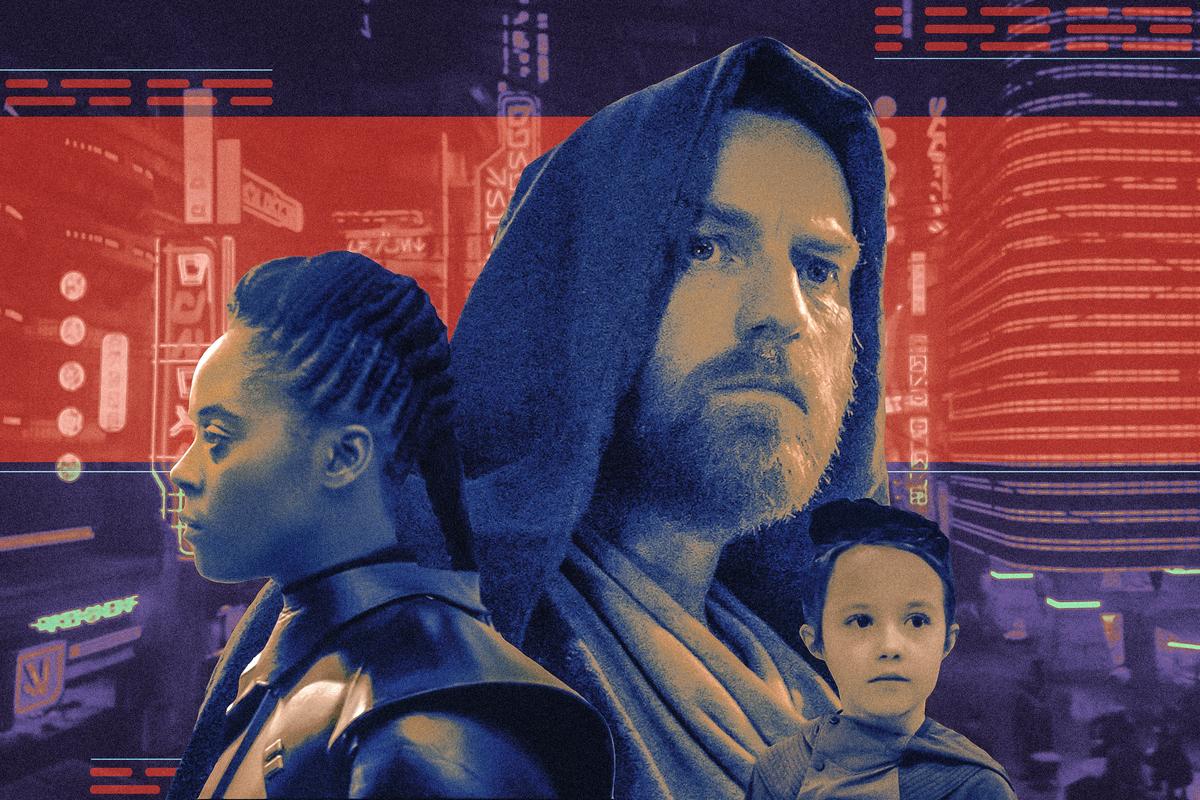

When we last met, he was a master. Now, he is but the learner.
The Obi-Wan we meet at the start of Obi-Wan Kenobi, which arrived on Disney+ with a two-part premiere on Friday, is not the one we remember from Episodes 1 through 3, a trilogy retold in four minutes before the series’ first scene. (Previously on … the prequels.) He’s a little grayer and a good deal more weathered, though not nearly to the degree of Alec Guinness circa Episode IV. (By all appearances, Kenobi’s next nine years are gonna be rough, though nine years from now, Ewan McGregor will be only three years younger than Guinness was in 1977.) Ten years on Tatooine has punished him, sure, but mostly he’s punished himself.
By day he suffers survivor’s guilt; by night he has nightmares of Mustafar. His Order is dead, his lightsaber buried. Once at the center of galactic goings-on, he’s now a cave-dweller clinging to the planet that center is farthest from. Both by choice and necessity, he’s cut off from the Force, his skills as rusty as a Jawa’s wares. It’s not safe for him to tap into what gives a Jedi his power—not just because it could give him away to the dark siders who hunt him, but because he doesn’t trust himself to use it. The Force may bind the galaxy together, but a decade after the fall of the Republic, the galaxy is broken, possibly beyond repair. And “Ben” believes the dark times are largely his fault.
The “last ember of a dying age,” as the Grand Inquisitor calls him, has hidden his light beneath a bushy beard. It’s a predictably bleak beginning; no wonder Disney decided to drop two episodes at once. By the end of the second installment of Obi-Wan Kenobi, the six-part saga’s story is set up, and its important pieces are in play. Its protagonist has reluctantly left his cave, and much as he’d rather be Ben, he’s back to being Obi-Wan, and he’s started to relearn what he has unlearned. He has also learned something new: The Sith lord formerly known as Anakin Skywalker is still alive—and looking for him. As for Anakin’s offspring, it’s not Luke we meet early on, except through a pair of macrobinoculars. No, there is another. And—wouldn’t you know it?—Obi-Wan is her only hope.
Obi-Wan Kenobi doesn’t start slow: It opens with a flashback to the fall of the Temple, giving director Deborah Chow a chance to show off the prowess as an action chronicler that she demonstrated in The Mandalorian. No matter how many times I see it on screen, Order 66 always leaves me with a lump in my throat, and this scene is no exception: As murderous clones attack her trainees, a previously unknown Jedi, Minas Velti, gives her life to protect them. “What do we do now?” one youngling asks after Velti takes a blaster bolt. “We run,” another answers. (Not to the Council Chamber, one hopes.)
Ten years later, those who haven’t perished are still running, and almost immediately we see why: A shadow cuts across Tatooine, marking the coming of the Inquisitors. Hasn’t Kenobi been through enough? Can’t a strange old hermit be a humble butcher and wrap up slices of steak in peace? Nah. If you really want to go to ground in the Star Wars universe, Tatooine is the worst place to hide, because Lucasfilm can’t quit the place. Scarce as survivors of the Jedi Purge are, after the mass slaughter of Order 66 and the escapees’ subsequent snuffing out by Darth Vader and his Inquisitors, there are apparently two of them on Tatooine. Obi-Wan has trained himself to repress his instinct to help others—the scent that Vader’s bloodhounds are adept at picking up—but the other, an ex-Padawan named Nari (Benny Safdie) who’s hardly worth the Inquisitors’ time, is still scratching the itch of the Jedi Code. He’s made the mistake of showing compassion to one of Tatooine’s respectable small-business owners, and as a consequence, he’s brought the bloodhounds down on Obi-Wan’s hiding spot.
The Inquisitor contingent consists of the Third Sister (Moses Ingram), the Fifth Brother (Sung Kang), and the Grand Inquisitor (Rupert Friend). Only the Third Sister, Reva—who may be one of the younglings from the earlier scene—has another name, which identifies her as the Inquisitor of interest; she’s also the only original character, the Fifth Brother and Grand Inquisitor having debuted in Dave Filoni’s animated Rebels. (To be honest, the latter looks a lot less grand and intimidating in live action, where he reminds me more of a Conehead than a sinister enforcer for the Sith; at times, Obi-Wan Kenobi’s production values dip well below The Mandalorian’s level, looking more like Disney Channel than Disney+.) The Empire’s iron fist is still clenching, and Tatooine isn’t occupied yet, but the Inquisitors’ reputation precedes them, as evidenced by this introductory exchange:
Grand Inquisitor: You know who we are.
Saloon Keeper: Inquisitors.
Grand Inquisitor: You know what we do.
Saloon Keeper: You hunt Jedi.
Hey, now the portion of the audience that hasn’t encountered Inquisitors before knows who they are and what they do, too! Exposition achieved. The memory of the Jedi hasn’t yet faded from the galaxy, and some fondness for the former guardians remains, but the Inquisitors can sniff out their quarry without anyone nodding a head in Nari’s direction. Reckless Reva is ready to slice him in half, but the Inquisitor, who wants to interrogate him, stays her blade. The Jedi refugee flees as Reva and her boss have a chat about priorities: She has her white whale, Kenobi, on the brain, but he orders her to focus on solid, if less alluring, leads. “Consider him forgotten,” she mutters under her breath.
And so he is, almost. Obi-Wan is earning his daily protein intake on an assembly line leading out from what appears to be the carcass of a Krayt dragon. He just wants to stay out of trouble, eat home cooking à la Rey on Jakku, keep a close eye on Luke, and earn enough to buy the boy little gifts like the T-16 skyhopper toy that’s still entertaining him in Episode IV. His monotonous existence is straight out of the three issues of Jason Aaron’s Star Wars comics that depict his day-to-day in the two years preceding this series. In those stories, too, Obi-Wan left offerings for his ward like a sad dad who doesn’t have custody. And he suffers a similarly frosty reception from Owen Lars, who isn’t interested in coparenting; when Owen later refuses to give Obi-Wan away with Reva’s blade at his throat, he keeps the secret for Luke’s sake, not Obi-Wan’s. (Poor Reva does get to chop off one hand, at least, in classic Star Wars fashion.)
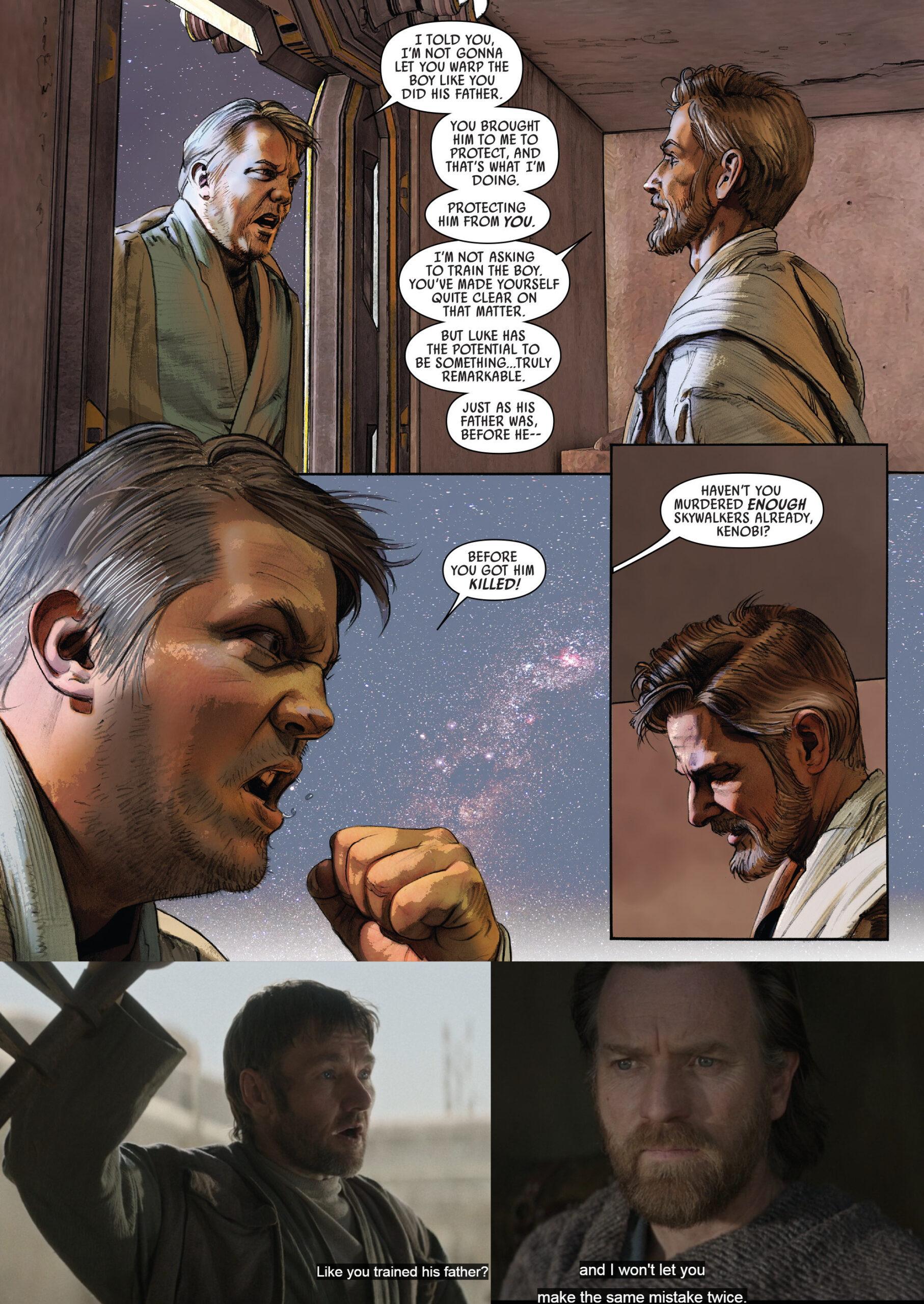
Obi-Wan wants Luke to remember him, but he’s dismayed to discover that someone else knows who he is. Nari, who’s still eluding the Inquisitors, is seemingly on Tatooine to find him, which suggests that his tracks aren’t quite as covered as they’re supposed to be. Nari is a true believer who’s hoping Obi-Wan will protect him from the Inquisitors and help him network with other survivors. Obi-Wan, after initially pretending to be someone else, drops his cover and tells Nari to leave before he attracts too much attention to Tatooine. The only help he offers is the advice to do what he did: Bury his lightsaber like a black melon, stay hidden, and live a “normal life.” (If you can call living in a cave and spying on a minor normal.) Nari is appalled, wondering what will become of the people who need them, and the fight against the Empire. “The fight is done,” Obi-Wan says. “We lost.”
Nari also wonders what became of the Obi-Wan of old. “What happened to you?” he asks. “You were once a great Jedi.” Well, it’s a long story, Nari; you must have missed that four-minute recap. Instead of bringing him up to speed on his role in the Order’s downfall, Obi-Wan informs him, “The time of the Jedi is over.”
Obi-Wan’s pronouncement echoes a quote from his once and future assailant, Darth Maul, who once told Ahsoka, “The time of the Jedi has passed.” It also presages a line from another old Master who’ll one day turn down a request for assistance with the words, “It’s time for the Jedi to end.” That’s right: Obi-Wan is watching over the young Luke, but he’s not unlike the old Luke. In 2018, The Last Jedi director Rian Johnson explained that Luke had deprived himself of the Force and hidden himself on Ahch-To not only because of the tragic end of his reestablished Order, but because of Leia. “If he could see his sister suffering,” Johnson said, “if he could hear her calls for help, there’s no way he’d be able to do what he thinks in his head is what he has to do—which is to stay on that island for the greater good of the galaxy.”
Obi-Wan thinks he has to stay on Tatooine for the same reason: His duty is to Luke, and the hope for the future that Luke represents. But he too will be brought out of seclusion, and for the same reason: Leia needs his help.
When we meet the precocious princess, on a verdant, pre–Death Star Alderaan, she’s pulling the same trick her mother often used: disguising an attendant as herself. (When she’s not wearing clothes that resemble Leia’s future fits, she dresses like Padmé, too.) The real Leia is sitting in a tree with her droid, Lola—which will vie with BB-8 and BD-1 for most endearing droid, compact class—staring at the sky and identifying each ship that flies by. The Skywalker seed is strong: Leia, whose hair is coiled in one bun on the top of her head, may be more knowledgeable and refined than Luke, whom Obi-Wan watched pretending to pilot a ship, but she has the same appetite for adventure. Also like Luke, she’s confined to her adoptive planet, though for very different reasons. As Alderaanian royalty, she has state functions to attend; her job, until she’s old enough to head off to the Senate, is to smile, wave, and play the proper princess at her parents’ side, while also effortlessly ethering the stuck-up cousin who doesn’t see her as a real Organa.
Unsurprisingly, C-3PO is on the scene, and Jimmy Smits is back as Bail Organa, though Bail’s wife, Breha, has been recast since Revenge of the Sith. It is somewhat surprising, though, that Leia appears so early and plays such a prominent role, when a compelling plot probably could have been built around Obi-Wan, Vader, Luke, and the Inquisitors. (Maybe that’s not a bad thing; at this stage of the kids’ development, Leia leads a more interesting life.) Much prerelease reporting and speculation suggested that Luke was the Skywalker kid Obi-Wan would be safeguarding in Mandalorian/Lone Wolf and Cub–esque fashion; in actuality, it’s Leia, though like Omega in The Bad Batch, she’s hardly helpless on her own. Another prerelease possibility was that Obi-Wan would leave Tatooine to draw the Inquisitors away from Luke, but as it turns out, they weren’t on Tatooine for either Luke or Obi-Wan.
If I have a critique of the structure of these first two episodes, it’s that Nari (and the Inquisitors’ visit to Tatooine) seems somewhat extraneous and contrived. Yes, Obi-Wan’s rejection of Nari—who gets strung up in the town square, having failed to follow in Obi-Wan’s low-profile footsteps—hammers home that this isn’t the Obi-Wan we once knew. But the chapters provided more than one example of Obi-Wan holding back his abilities, and he could’ve left Tatooine in the same way without the Inquisitors ever setting foot there. It’s just a tad overcomplicated to have Vader’s lapdogs show up at Obi-Wan’s Outer Rim doorstep but not make that the reason he leaves; the Inquisitors have been searching for Obi-Wan for 10 years, but Reva coincidentally lures him out of hiding (and away from Tatooine) immediately after unwittingly strolling through his neighborhood and threatening Owen while Obi-Wan watched from a few feet away.
Even after that close call, Obi-Wan would stay on Tatooine if he had his druthers. The real reason he leaves is that Leia, while on another outdoor excursion, is kidnapped by Vect Nokru, a mercenary played by precisely the person we all expected to see guest-starring in Obi-Wan Kenobi:
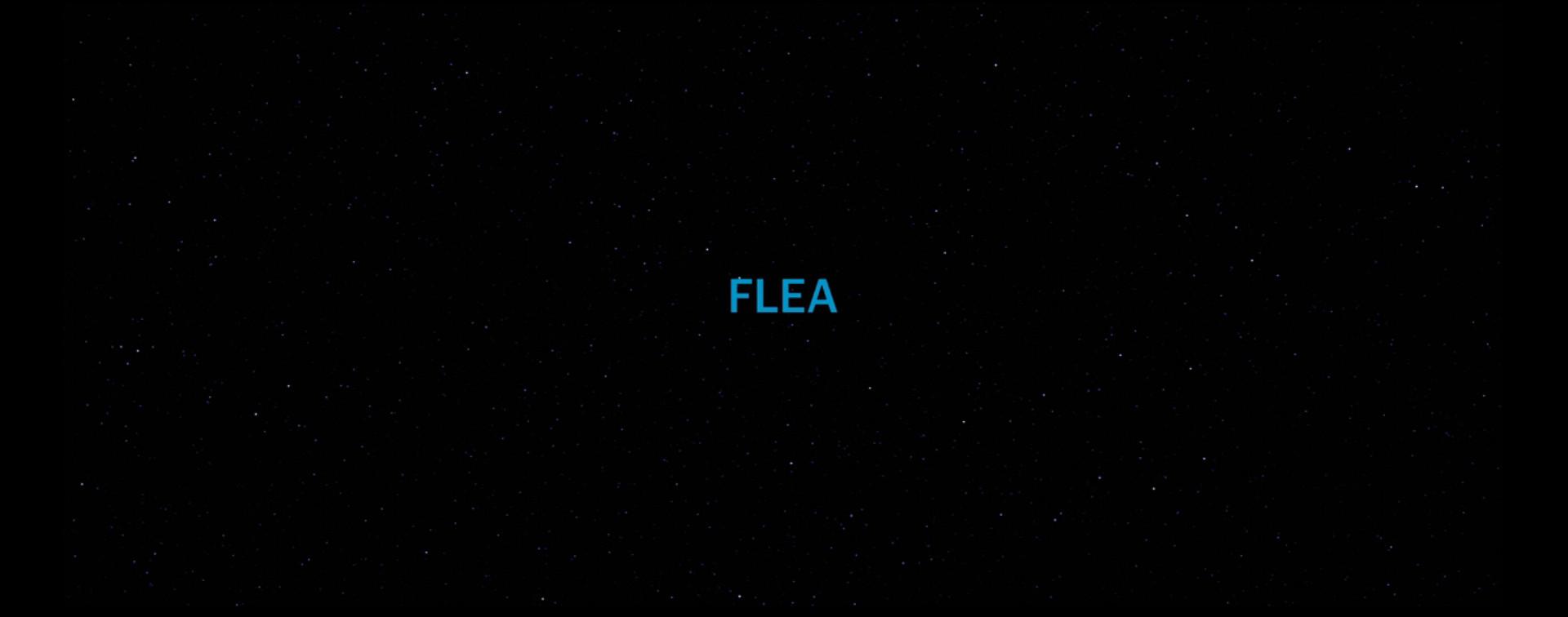
The makers of The Mandalorian like to cast comedians in recurring roles; maybe the makers of Obi-Wan have a hankering for alt-rock icons. (Chow did direct the video for the lead single on the Chilis’ latest album, using the same ILM tech as this series.) Vect takes Leia to his bass—sorry, base—on the planet Daiyu, a new wretched hive of scum and villainy that’s much more neon than Mos Eisley. Bail breaks radio silence to ask Obi-Wan for help, and for the second time, he refuses to assist someone from his old life—ostensibly because he can’t leave Luke, but also because he doesn’t see himself as a hero or rescuer anymore. “I’m not who I used to be,” Obi-Wan says. “Find someone else. She’ll be better off.”
Only Obi-Wan knows who Leia really is and how important it is to retrieve her, so Bail won’t send anyone else in his stead. (You’d think it might still make sense to send his army, though.) No one in Star Wars can resist a trip to Tatooine, so—presumably breaking all protocols for maintaining Obi-Wan and Luke’s secrecy—he shows up in Obi-Wan’s lightly furnished cave, makes an in-person appeal, and talks him into “one last fight” to save a Skywalker. Contradicting his own recommendation to Nari, Obi-Wan rides his faithful eopie into the desert and digs up his and Anakin’s lightsabers. By unearthing the blades—and exhuming the memories that come with them—he ensures that some 44 years later, Rey will be able to rebury Anakin’s (and Luke’s) saber—along with Leia’s—elsewhere in Tatooine’s sands, with the Force at least briefly rebalanced.
Armed with an old weapon and a new mission, Obi-Wan heads for the spaceport. He’s much more apprehensive than Luke or Leia would be about taking a trip off planet, but then he’s never really liked flying. He’d like it even less in this case if he knew what was waiting for him: He walks into a trap set by Reva, who correctly predicts that putting Bail’s daughter in danger will draw his old buddy Obi-Wan out of the shadows.
The start of the second chapter brings not only a merciful change of setting, but also an improvement in pace and a switch from the reclusive Obi-Wan of Episode IV to the detective Obi-Wan of Episode II. Obi-Wan is a fearsome fighter with a saber in his hand—though he’s not exactly a crack shot with a blaster—but as enjoyable as his battles have been, it’s even more fun to watch him use his head. In Daiyu, he’ll have to: “All signals in or out are blocked,” he learns, because “people like their secrets here.” (Maybe he should have hidden here instead of on Tatooine.)
As Obi-Wan walks the mean streets of Daiyu, he has two encounters that call back to his history. First, he sees a beggar with a familiar face: It’s a prematurely aged ex-Republic clone trooper, played by Temuera Morrison of Jango Fett, Boba Fett, and Commander Cody fame. (Playing a character in Attack of the Clones who had millions of clones was a wise career move for Morrison.) The veteran wears the armor of the 501st, the unit that fought Obi-Wan and Yoda at the Temple and would later serve as Vader’s personal legion. Despite that turnabout—and the fact that the clone’s implanted programming might still force him to try to kill Obi-Wan if he knew he was a Jedi—the ex-Republic general drops a coin in his former ally’s helmet. It’s not the clone’s fault that he had to execute Order 66. Next, Obi-Wan is solicited by a drug dealer (played by McGregor’s daughter, Esther Rose) who tries to sell him spice; perhaps it’s a sign of his singular purpose that he only asks for information and doesn’t try to persuade her to go home and rethink her life.
Just as Obi-Wan is wondering where to go, he’s accosted by a kid named Jayco who offers to take him to a Jedi who “helps people.” Intrigued, he goes along, which is how he meets Haja Estree (Kumail Nanjiani), one of the cleverest characters created for a Disney Star Wars series to date. Haja is a grifter who pretends to be a Jedi through judicious use of robes, magnets, and showmanship. (Working with a partner on the other end of a commlink, he announces, “This is a Jedi mind trick. … I’m inside your mind.”) Haja is conning unsuspecting people out of credits, but he’s not all bad: Although he’s overcharging the mother and Force-sensitive child who are trying to leave the planet, he is actually arranging for their safe passage to Corellia. (Which isn’t the greatest place to live either, judging by Solo; however, in the credits the kid’s name is Corran, which may mean he’s the long-decanonized Corellian character Corran Horn.) After Obi-Wan exposes his con act, Haja, who has his ear to the ground and knows these things, tells him where Leia is being held.
Obi-Wan enters through a meth-lab-looking room and soon finds himself in a hallway altercation with a pair of ruffians; it’s his first fight in a while, and it shows. He takes out his first two opponents, but a few more, including the ringleader, get the drop on him when he falls for the ol’ “droid in a cloak” trick. “You’re not a Jedi anymore, Kenobi,” Vect says, after slapping him all over the bass base. (Sorry, last time.) “You’re just a man.” Obi-Wan would probably be the first to agree. But he does have a trick up his sleeve: the drugs the dealer gave him out of sympathy for the story of his missing daughter. He breaks them open, escapes in the cloud of narcotics, and collects a suspicious Leia, who punches him once more for good measure. Leia is unimpressed by her savior—“Where’s the army?” she asks—but she agrees to go with him, and they leave with the newly arrived Reva hot on their heels.
Leia spots Obi-Wan’s lightsaber, but she has her doubts: He refuses to levitate her, “Ben” doesn’t sound to her like a Jedi-esque name (rude), and he “seem[s] kind of old and beat up.” Tough crowd. She also psychoanalyzes him as easily as she did her cousin, announcing, “You think the less you say, the less you give away. But really it’s the opposite.” She may have a future in politics someday. (Obi-Wan sees some Padmé in her, and so can we; Vivien Lyra Blair gives a convincing performance as a girl who could grow up to be Carrie Fisher.) Meanwhile, the Grand Inquisitor arrives, two other Inquisitors in tow, and confronts Reva for kidnapping a senator’s child to ensnare Kenobi without telling him first (and, obviously, clearing the plan with Inquisitorius legal). At last we learn why she’s so obsessed with Obi-Wan: “She thinks she will gain favor by capturing Kenobi,” Fifth Brother growls. Favor with whom? We can guess, though Kenobi can’t yet.
“Whatever power you are craving, it will not change what you are,” the Grand Inquisitor tells her. “The least of us. You came to us from the gutter. Your ability gave you station, but all the power in the world can’t mask the stench beneath.” Reva responds, “Maybe that stench is your failure.” The Grand Inquisitor dismisses her and sets out to capture Kenobi and take the credit herself, which prompts Reva to tell Vect to rustle up every available lowlife to put pressure on Obi-Wan. Judging by what we’ve seen so far, the Inquisitors seem to have a serious discipline problem, though to be fair, obeying the chain of command isn’t a strong suit of the Sith either.
Reva’s plan pays off: When Obi-Wan knocks out an attacker, Leia notices that the hunter was carrying a holograph of her supposed protector, which suggests to her that he isn’t on her side. She bolts and leads him on the lowest-speed chase through a crowded city since The Book of Boba Fett’s third chapter, at one point dashing between the legs of a large alien in a possible homage to a deleted scene from Episode IV.
When he heads for the rooftops, Obi-Wan follows, and the bounty hunters do too. Reva spots their blaster fire from afar and starts Force-parkouring over in our heroes’ direction. A desperate Leia, ignoring Obi-Wan’s pleas, tries to leap across a gap between roofs and ends up dangling from a wire. She loses her grip, plummets toward the ground, and leaves Obi-Wan no choice but to clear away the cobwebs and use the Force for the first time in years to break her fall. “You really are a Jedi,” says Leia, who may be more convinced of that than Obi-Wan is.
The episode’s climax unfolds quickly. Haja, who’s followed the chase, offers Obi-Wan a way out: He doesn’t have Force powers, but he can still be of assistance. He points Obi-Wan toward a cargo port and gives him a key to a transport. “It goes to Mapuzo,” he says. “They’ll be waiting.” Obi-Wan doesn’t trust Haja—who’s touched that the real Jedi remembered his name—any more than Leia initially trusted Obi-Wan, but like Leia, he has no choice but to place his faith in someone who says he wants to help.
As Obi-Wan and Leia head toward the transport, Haja bravely heads off Reva and pretends to be a Jedi. She’s no more fooled than Obi-Wan was, and she rips the knowledge of Obi-Wan’s destination from his mind. Meanwhile, Vect gets an uncomfortably close shave from the Grand Inquisitor’s spinning lightsaber. Everyone knows where the target is going, and the time for a confrontation comes.
In the quiet cargo port, Reva stalks Obi-Wan. He’s not going to die today, she promises him; she’s just going to take him to … who? And then, the reveal: “Lord Vader will be pleased.” Obi-Wan, stunned, recognizes the name; he’s heard it once before. “You didn’t know,” Reva says, sensing his horrified reaction. “He’s alive, Obi-Wan. Anakin Skywalker is alive. And he’s been looking for you for a long time. And I will be the one to deliver you to him.”
The Grand Inquisitor, who arrives right then, has something to say about that. When he makes a move for Obi-Wan, Reva impales him with her blade, and he collapses. While the Inquisitors are squabbling and stabbing each other, Obi-Wan joins Leia in the transport, and the two take off. She knows something is wrong, but he can’t muster any words, save for one: “Anakin.” And then, in the episode’s closing seconds, Obi-Wan’s breathing merges into that of his red-eyed former apprentice, who floats far away in a bacta tank. His trademark respiration hisses in and out, sounding disconcertingly like “Ohhh-biiii.”
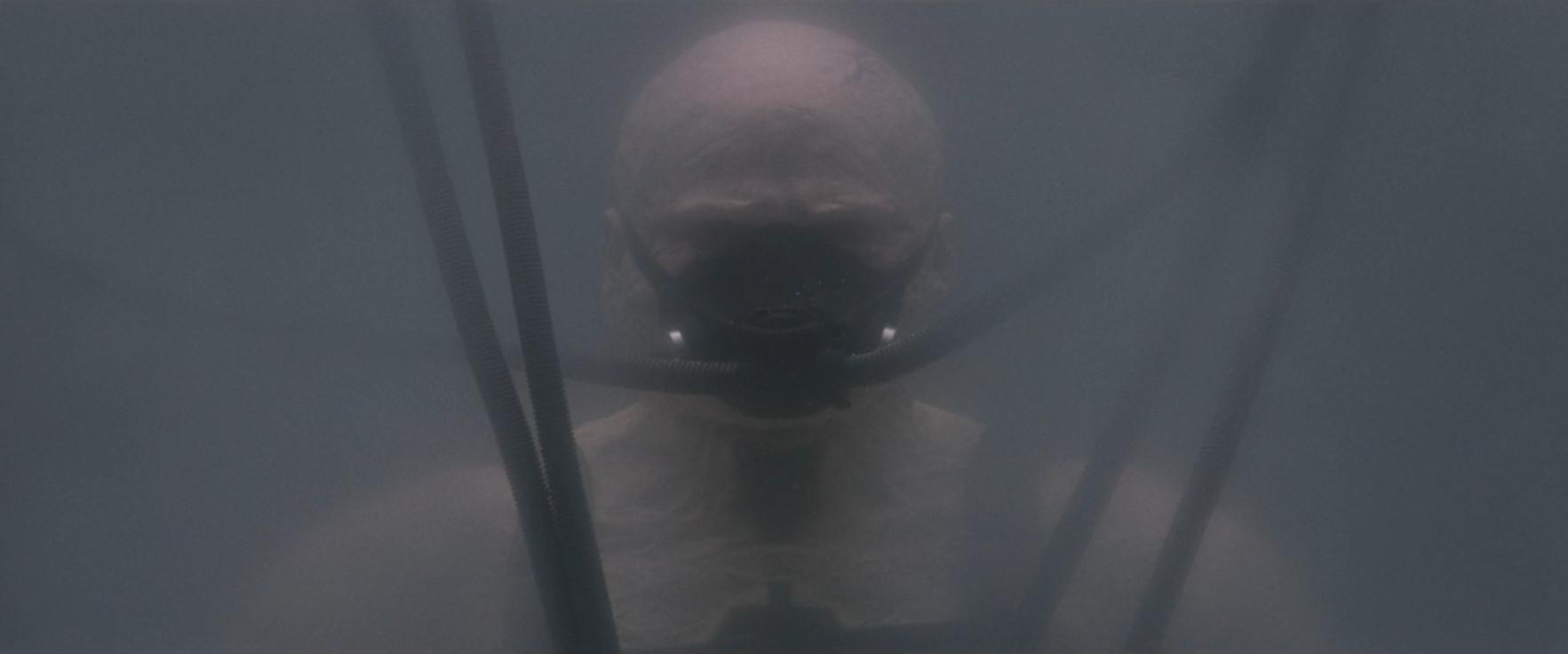
It’s a bold way to end the second episode of a six-episode miniseries: This is the moment we were waiting for, the one where Obi-Wan learns that his nightmares can extend to his waking life too. In that instant, all of the pain of the preceding 10 years is etched onto McGregor’s face. Maybe the moment would have hit even harder if Obi-Wan had discovered Vader’s survival by seeing him, rather than hearing he was alive from someone else, but this way we have another devastating scene to look forward to.
And there’s plenty to speculate about in the meantime:
- Is the Grand Inquisitor dead? Unless this series is ignoring preexisting canon—or this Grand Inquisitor happens to look the same as the Grand Inquisitor who survives into Rebels—then probably not. (Maybe they can rush him to the Modifier from Book of Boba, or uncork a clone.) But if he survives, Reva may become as much of a fugitive from the Empire as Obi-Wan is, in which case her only chance at a pardon could be bringing him in.
- Speaking of Reva: How does she know that Vader is Anakin Skywalker? The Emperor probably didn’t put out a press release. Obi-Wan, living off the grid on Tatooine, didn’t even know the Sith lord was alive, which is plausible; Vader may be Palpatine’s sidekick, but that doesn’t mean he’s a fixture on the HoloNet news. Could Vader, in his pre-Mustafar form, have spared Reva at the Temple because she showed some special promise? Might there be a bond between them because they both rose from what much of Imperial leadership would dismiss as the gutter? What does Reva think she’s owed?
- Who are the “people out there who can help” Obi-Wan? Could it be Ahsoka and her allies, who by this time have formed a network of proto-rebel operatives? And why won’t Qui-Gon talk to Obi-Wan, 10 years after Yoda promised to teach Obi-Wan to commune with the dead Jedi? Is it because Liam Neeson won’t take a live-action TV role? Or does Obi-Wan just have to be more attuned to the Force and at peace with himself to hear his former master’s voice, as he has in the books? Can Kenobi “move on” and “be done with” the past, as Bail exhorts him to, as long as the living embodiment of his failure remains armored and masked?
- And how will this series square with events to come? Not only do the first two episodes avoid any retconning of, for instance, why Obi-Wan and Luke are still using their real surnames, but we know now that it hasn’t been that long since Episode IV’s Obi-Wan has heard his name, just as it probably hasn’t been that long since Vader felt his presence. (And if Vader is “but the learner” when they meet in this series, it’s because he’s still studying how best to be evil.) One wonders, too, why Leia’s holographic plea to Obi-Wan in Episode IV, which began with “Years ago you served my father in the Clone Wars,” didn’t also say, “And fairly recently you rescued me on Daiyu.” Presumably Leia was out of earshot when Reva called “Ben” Obi-Wan in Chapter 2; maybe she also failed to read the caption on the bounty hunter’s hologram that spelled out her rescuer’s real name. If so, Obi-Wan’s writers will have to keep coming up with ways to deny her the knowledge that the Ben who saved her is the same as the “Ben Kenobi” whose name she seems to recognize when Luke enters her Death Star cell.
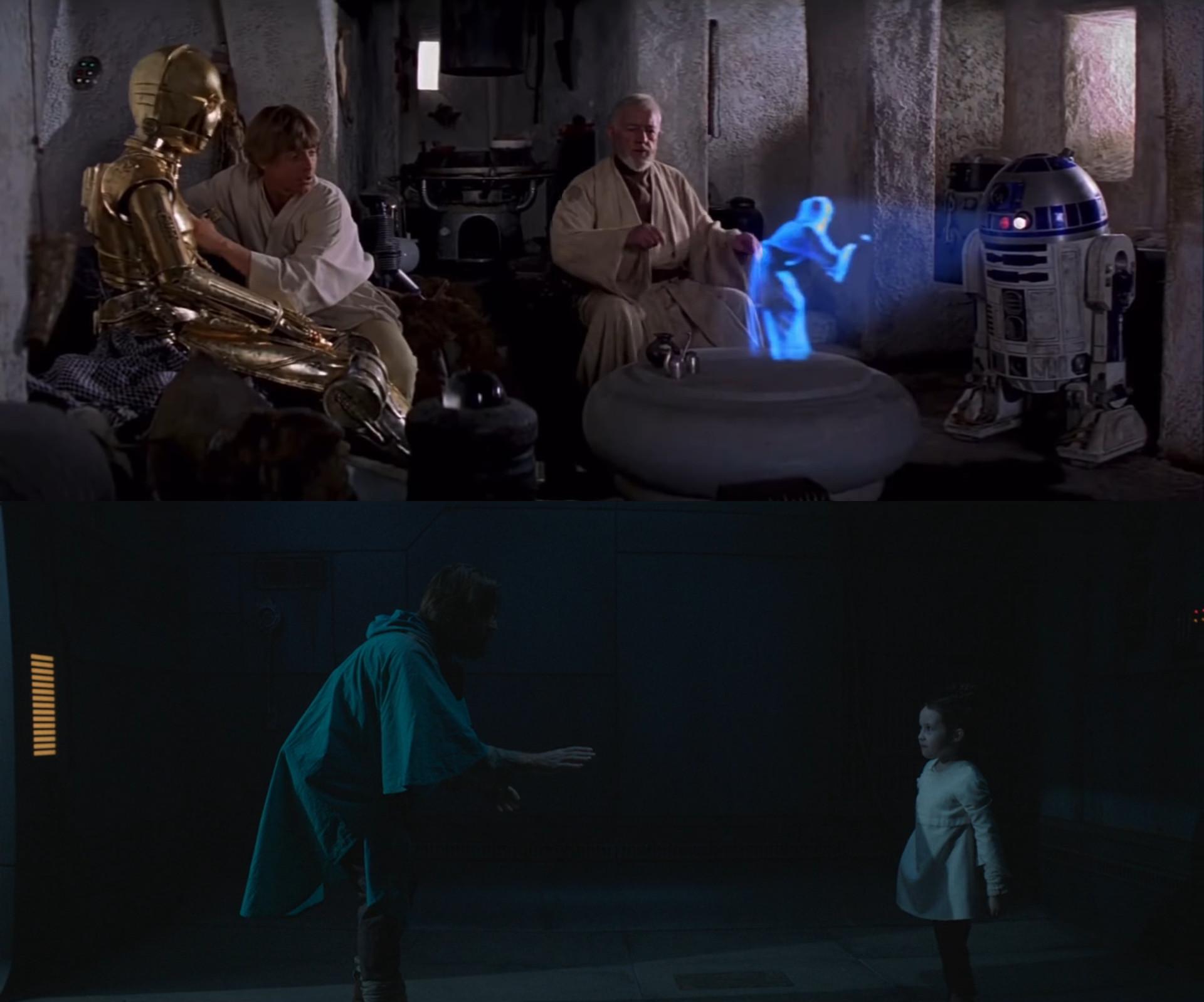
“I’m not the man you remember,” Obi tells Bail, who responds, “Well, you’re going to have to be.” We remember both the man he was and the man he will be, and we know that nothing that happens in Obi-Wan Kenobi can change the fact that Luke, Leia, Vader, and Obi-Wan will wind up on the Death Star nine years later. But what we lose in suspense, we gain in fascination with how they became the characters we first met. We also got a vintage, self-referential John Williams theme. We got Easter eggs for the diehards, including Bail’s purrgil mention, which was catnip for fans of Rebels (and maybe a tease for Ahsoka). We got Haja saying “Yeah, I know” in response to “The Force is so strong with you.” And best of all, we got Obi–Ewan McGregor back. That alone is reason enough to tune in next Wednesday.

